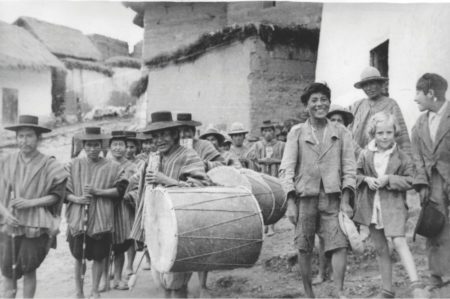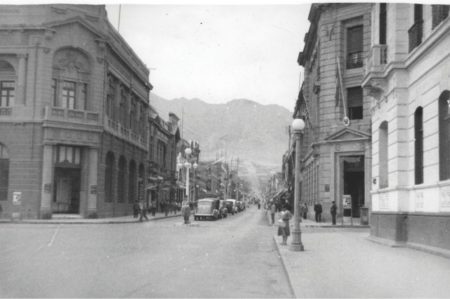Snow crunched under foot and crisp winter winds whipped rosy color into the cheeks as worshippers, bundled in warm winter clothing, hurried into the “Little Homelike Church” – Trinity Lutheran Church of Minnehaha Falls – the night of December 5, 1937. As Weinhardt and Carlsen knelt at the altar rail in front of the picture of Christ in Gethsemane, their wives watched as Pastor Conrad and Pastor Granlund laid hands on them and commissioned them to go as ambassadors and servants of the living God to South America.

Eight days later, on December 13, Weinhardt kissed his wife goodbye and headed for the West Coast. Carlsen followed on December 30 and met Weinhardt in Shelby, Montana. From there the men proceeded together to Seattle and then down the West Coast.
In San Francisco they decided to visit the consulates of Peru and Bolivia.
“Go to my country,” the Bolivian consul pleaded. “My people live in poverty, sickness, superstition and ignorance. You can do much to help them.”
On Friday morning, February 18, at 11:15 a.m., carrying their suitcases, they climbed the gangplank of the S.S. Margaret Johnson and descended to their third-class quarters. When they returned to the deck, they looked down to see standing on the dock Mr. and Mrs. Martin Lien of Pasadena, Mr. and Mrs. Peterson of Valier, Montana, and Miss Agnes Johansen of Los Angeles. Joyfully they invited these friends to come on board and they visited with them until 2:30 p.m. Then the “All visitors off!” call sounded, and the friends had to leave.
“Goodbye, goodbye!” waved the five friends from the pier below, smiles and tears all mixed up on their faces. “God go with you and before you and open doors.”
“Goodbye, goodbye!” called the two men, thinking also of their wives and children they were leaving behind.
The ship’s whistle sounded. The pilot boat alongside gently nudged the ship away from the pier and steered her out into the open sea…
At Panama the men changed ships. Their second ship brought them to Mollendo, the port town of Arequipa in southern Peru, Thursday, March 10, where they decided to disembark. They went ashore by launch and passed through customs. Eleven days later they boarded a train for La Paz, Bolivia.
The little cogwheel train on which the men found themselves puffed and chugged as it began its ascent. Carlsen and Weinhardt sat upright on the straight-backed hard seats, shaking and jerking from side to side as the train jolted along. From time to time the men would grab their seats and (continued on page 2) hang on as the cogs would slip, causing the little train to shoot backwards. Dirt and soot sifted in. As they continued to climb the men saw groups of Aymara Indians. Some huddled under brightly-colored handwoven shawls. Some of the men wore tweed coats and trousers, laboriously patched, one repair upon another. The largest patch the men saw was a huge square of burlap from a gunnysack that covered almost the entire back of the jacket. The wide, homespun woolen skirts of the women were almost threadbare, and some were worn through to the lining. The women, for the most part, were barefoot, their feet chapped and full of scales. The men shuffled along in sandals made of old rubber tires.

As the sun sank out of sight the wind whipped and howled through the cracks in their coach, and the men pulled their coats tighter about them. An attendant brought them blankets and hard round pillows, but the men slept little. As their train reached altitudes of 14,000 feet and above, the men sat up, gasping for air and clasping their chests and stomachs which were knotted in pain.
The next day the men stared with amazement as they caught sight of huge Lake Titicaca, lying at an altitude of 12,500 feet. At Puno, a small city at the northern end of the lake, the little train ground to a stop. The men gathered up their baggage and walked, puffing and panting in the thin air, to the steamboat that would carry them to another train waiting at the southern end of the lake.
On and on the second train chugged, the men fighting nausea and longing for their journey to be over. And then suddenly they found themselves on the rim of a vast deep hollow. Looking down they saw the city of La Paz, the gem of the Andes, sprawled out below.
A feeling of keen excitement came over the men as their train wound its way down into the city. They chugged alongside narrow, cobblestone streets, past adobe buildings, past patios, courtyards and buildings with balconies and red-tiled roofs, until at last they puffed to a stop at the depot. There a Mr. Irle of the American Clinic, a mission project of the Methodist Episcopal Church, met them and invited the men to stay at the clinic while they were in La Paz. Gratefully the men accepted.
As they rode along into the city, the men in their hearts gave thanks to God. He had brought them this far. Surely he would lead them now to the place where they should begin work…